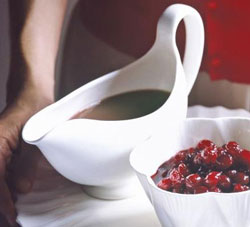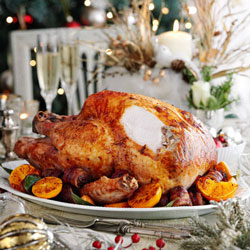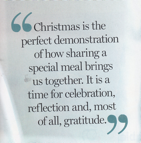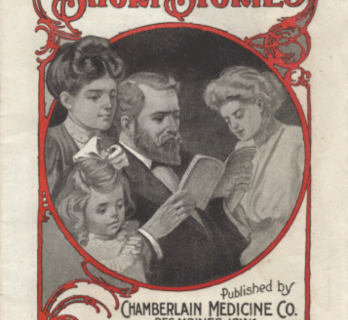Susan Bell and Lynne Freeman
The Christmas meal is an event of considerable symbolic and commercial importance in many countries, certainly the UK and Australia where the research for this paper was conducted. As a symbolic event, Christmas is imbued with deep personal and cultural meanings for consumers. There is nothing quite like it for combining family dynamics, nostalgia and financial stress, to name just three of the potential tensions involved here.
How should brands talk to 21st Century women about making the Christmas meal? Should they focus on making it easy, or should they talk to us as aspiring domestic goddesses? Do they assume that we are novices at this, or that we know what we are doing?
This article describes how a semiotic decoding of the ‘perfect’ Christmas meal, as presented to UK and Australian women in the Christmas media, gave us new insights into how these conversations might go.
Initially our aim was to examine how the role of women has changed over the last 25 years, however what we found was that regardless of any social or economic changes women are still under enormous pressure to deliver the perfect Christmas.
Our analysis clearly showed that ‘perfect’ means not just how the food was cooked but how it was displayed; ‘perfect’ also required women to conform to what many might think are outdated notions of their role.
Our findings have broad commercial application for brands and retailers with specific Christmas marketing campaigns, for marketers selling any product to be used within a big symbolic event like Christmas or Thanksgiving, and for researchers who want to understand the importance of symbolism in the lives of consumers.
What we analysed
We conducted a longitudinal semiotic analysis of the depictions of the Christmas meal in the major women’s magazines of the UK and Australia: Good Housekeeping and Australian Women’s Weekly, respectively. These magazines had the widest readership amongst the female homemaker sector in their respective countries (Audit Bureau of Circulation, 2010, National Readership Survey, 2010). We analysed the December editions of these magazines over 3 decades up to 2013. We also included some of the December editions of the UK and Australian Good Food magazines. Each December edition had a dedicated Christmas food section which contained editorial (such as shopping lists and recipes) and supporting imagery.
Why Semiotics?
We used semiotics for this task precisely because of its three distinctive advantages over traditional qualitative research for understanding symbolic events and rituals.
First, symbolism is hard for consumers to talk about because symbols like the Christmas meal are complex repositories of meaning, taught to us as children, personally experienced or deposited in our minds through interaction with the world we live in. We often do not have introspective access to these impressions, and can rarely explain where these impressions come from. Helpfully, semioticians have developed a language to describe what symbolism is and how it works – concepts such as signification, denotation, connotation and myth.
Second, consumers can tell us about their personal experiences, needs and wishes but, like the proverbial example that fish cannot see the water they swim in, consumers cannot see the culture they live in, until they are outside it. Cultural trends are even harder to see because they are fleeting and vary from person to person. In other words, researchers need objectivity and distance when researching culture and cultural events. To achieve this objectivity and distance, semioticians have developed methods to help them study contemporary cultural artifacts such as products and media.
Third, much qualitative research with consumers has been about the emotional attachments that consumers have to brands. Arguably, because of the origins of qualitative research in psychology, the commercial research community has developed a shared – if evolving – language and conceptual framework about researching emotion. In contrast, symbolism is hard for researchers who have not been trained in semiotics to talk about. One of the advantages of semiotics then is that it equips researchers with the means to study important cultural events and rituals.
In summary, to understand the Christmas meal we used semiotics because it gave us a language, and conceptual framework to understand the potential shifts in meaning of an important symbolic event, and it gave us an objective method to study the way in which contemporary media have represented this event.
Social Semiotics
Broadly speaking there are three ‘branches’ of semiotics: Saussurian, developed in Europe, Piercian, developed in North America, and social semiotics, which was developed partly in Australia. The three branches share the same underlying idea, but give emphasis to different aspects of meaning-making. We used social semiotics for this project.
Social semioticians are interested in the way socially accepted meanings change as society evolves. For this project, the most relevant social change over the last 20 years in both countries is that most women in both countries are now in full time or part time work.
Social semioticians have also developed methods for studying texts (or ‘semiotic resources’ as they are called), which go well beyond the more familiar – essentially quantitative – content analysis. A semiotic analysis of texts looks at how words and images combine to create meaning together.
This analysis of texts has three parts. First, how the text is composed, for example identifying the words the colours, and the visual grammar of the composition. The second is about what kind of reality did this image portray? What assumptions and presumptions did the text imply of the reader? The third is how it addressed the user or reader. What kind of reader did they seem to have in mind? These are called ‘textural’, ‘ideational’ and ‘interpersonal’ respectively.
We used this comprehensive, disciplined and iterative analytical process for all the images and the contextualizing text in the Christmas section of each edition of the magazines we studied.

What we found
Twenty years ago, the magazines’ Christmas editions showed images of a home-prepared Christmas meal, on a table decorated with candles and baubles. The image was one of completeness, profusion and family togetherness.
In the early 2000’s, this picture of Christmas started to change. The focus was now on preparation, as women were shown serving the food. The magazines also started to give women ‘how to’ instructions. There was a significant shift in tone of voice to the reader over this period, from assumed knowledge to education.
From about 2004, Christmas started to feature celebrity chefs. The text told readers to emulate ‘Gordon’s ham’ or ‘Rick Stein’s feast’ (or something like that). Increasingly, the magazines featured visual images of male chefs, who were usually shown either sitting, or carving, but not serving.
From 2007, the visual images of the men got bigger, so in the end they were bigger than the visual images of the food. During the same period, the women were shown serving the food. In some cases, because the image was small, the woman was shown as torso only.
Over the same period, women were shown adjacent to Christmas decorations, but the men were not.

Some things did not change. The discourse was almost always about perfection. The magazines’ text informed readers each year that preparation and hard work were the key to perfection. One must make lists, buy ahead, make ahead and get up early on the day.
Using visual imagery, these magazines depicted a traditional Christmas meal (turkey or ham, with trimmings and a luscious dessert) alongside traditional Christmas decorations, symbolic of family togetherness, such as Christmas trees and crackers. Each year, the magazines also presented one or more alternative Christmas day menus, sometimes called the ‘Australian’ or the ‘budget’ or even ‘cheats’ version which was shown with much less food and virtually no Christmas symbolism.

The message about Christmas was clear: if you don’t put in the effort, you won’t be rewarded with family togetherness. Traditional food is important but what ‘tradition’ means has changed. Traditions are no longer passed down the generations. Instead, they are learned from celebrity chefs, the modern day oracles.
There are clear implications for the way in which brands ‘speak’ to women about the Christmas meal. Brands must demonstrate respect for how hard she has worked – and will expect to work – on the day. Don’t suggest she cheat, but do not expect her to feel proud of or loudly celebrate her achievement at creating such a meal, because to some extent she expects to be invisible. This is about the family, not about the cook.
A close semiotic analysis has revealed the expected but evolving cultural role of the women targeted by lifestyle magazines, generally the ‘mid-market’, in a way that would have been difficult to achieve through conventional qualitative research.
Susan Bell is Principal at Susan Bell Research and Lynne Freeman is a lecturer at the University of Technology, Sydney


